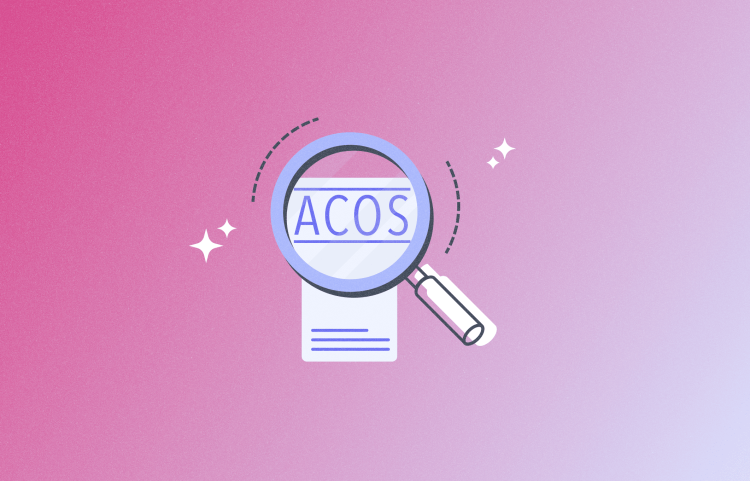
Amazon ACoS: What Is Advertising Cost of Sale and How to Improve It
Martin Saunders, September 28, 2021
Table of Contents
Amazon ACoS (Advertising Cost of Sale) is a key metric to measure the performance of an Amazon PPC campaign. If you’re new to Amazon advertising, this guide has everything you need to know about this metric—we’ll show you what ACoS is, how to calculate it, which metrics drive ACoS, and how to improve ACoS on Amazon. Let’s dive right in.
Looking for more Amazon PPC background, data, and insights?
Whether you’re interested in a high-level analysis of Amazon Advertising, a detailed look at recent marketplace trends, or a deep dive into the nuances of specific product categories, our 2022 Amazon Advertising Benchmark Report can help you gain insight into the Amazon PPC landscape.
The report is based on a comprehensive analysis of over 2 million Sponsored Products campaigns and you can download it for free today.
What Is Amazon Advertising Cost of Sales (ACoS)? How to Calculate It?
Definition: Amazon ACoS or Advertising Cost of Sales measures the efficiency of your advertising campaign. It is the ratio of ad spend to ad revenue (in %), and this can be applied directly to the Amazon advertising space. You can calculate your ACoS on Amazon with this formula:

What is the meaning of your Amazon Advertising Cost of Sales (ACoS)?
In short, ACoS shows how much of every dollar that was earned with advertising was spent on an ad campaign.
For example, let’s say a campaign has generated $400 of advertising sales. If the ads for this campaign cost $100, then ACoS = 100 / 400 * 100 = 25%.
So for every dollar made, 25 cents have been spent on advertising.
Top sellers use cutting-edge advertising tools
Perpetua offers the most advanced Amazon PPC solution on the market, with all the tools, resources, and expert support you need to build successful campaigns for your products. And what’s more, it couldn’t be easier to get started. Request a free demo today to discover the industry’s premier optimization and intelligence software for Amazon Ads.
Amazon ACoS vs. Amazon RoAS
You can't talk about ACoS without mentioning RoAS, so here we explain the relationship between the two metrics.
What is Amazon Return on Ad Spend (RoAS)?
Return on Ad Spend (RoAS) also measures how efficient your PPC campaigns are. Your Amazon RoAS is calculated by dividing ad revenue by ad spend, and it tells you how much money you earn for every dollar you invest in advertising.
What’s the difference between Amazon ACoS and Amazon RoAS?
Not much, actually. RoAS is the inverse of ACoS. So essentially, it’s just looking at the same metrics from a different perspective.
ACoS = Ad Spend / Ad Revenue
RoAS = Ad Revenue / Ad Spend
Both ACoS and RoAS measure the same thing: the relationship between your ad revenue and ad spend—meaning Amazon ACoS and RoAS are both measures of efficiency and profitability.
To continue with the example from above, if a campaign has generated $400 of advertising sales, and the ads for the campaign cost $100, then RoAS = $400 / $100 = 4.0. This means that for every dollar you spend on advertising, you’ll earn $4.00 in revenue.
ACoS = how much money you spend on advertising for every dollar in ad revenue you make
RoAS = how much ad revenue you make for every dollar you spend on advertising

For your own reporting, whether you use RoAS or ACoS for analyzing your Amazon advertising campaigns is a matter of personal preference. However, it's important to be aware of both, as expressing your campaign efficiency as RoAS may provide a clearer comparison with the ROI of other marketing efforts.
Top sellers use cutting-edge advertising tools
Perpetua offers the most advanced Amazon PPC solution on the market, with all the tools, resources, and expert support you need to build successful campaigns for your products. And what’s more, it couldn’t be easier to get started. Request a free demo today to discover the industry’s premier optimization and intelligence software for Amazon Ads.
Already using Amazon PPC ads?
If you're already advertising on Amazon, you can compare all your most important KPIs with your competitors with our free Benchmarker tool. It gives you a product-by-product breakdown of your advertising performance, as well as the key metrics for your whole account. Get an edge on the competition with the Benchmarker today!
What Is a Good ACoS on Amazon: Benchmarks across Industries
ACoS varies widely depending on the marketplace, ad type, competition, product price, and many more factors. For a general idea, here are the median ACoS values across different categories on Amazon.
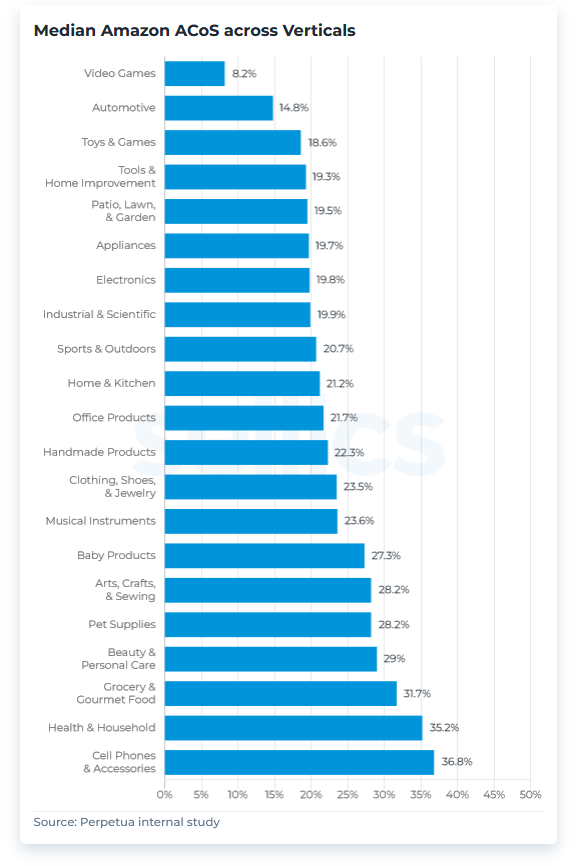
Amazon RoAS: Benchmarks across Industries
This second chart shows the RoAS, showing the return for every dollar spent on advertising. By comparing the two charts, you can clearly see the relationship between ACoS and RoAS.
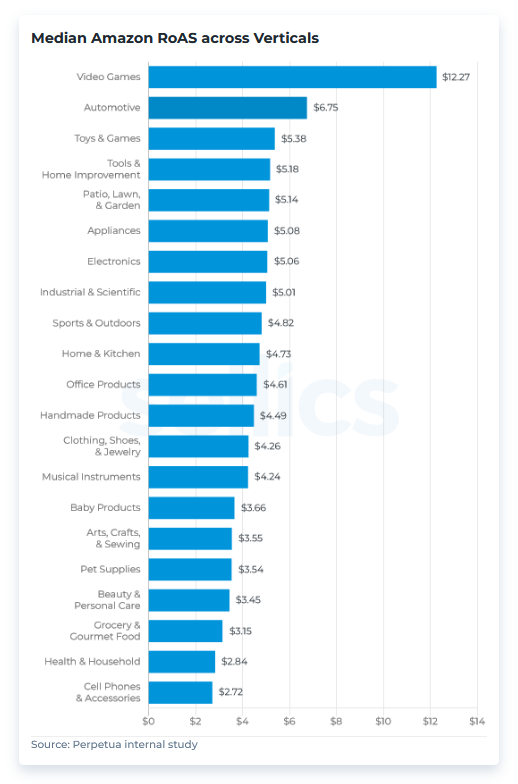
How to get a free, detailed benchmark for your niche and marketplace
The problem is that the numbers above are not detailed enough to answer the question every advertiser on Amazon is asking: “Is my ACoS good or bad?” To get a meaningful answer to this question you need to get benchmarks on country, subcategory, ad format, and individual-product levels.
Based on data from over 170,000 products and $2.5 billion in ad revenue, the free Benchmarker allows you to get precise category benchmarks on a country, subcategory, ad-format, and individual-product level, making it easy to identify growth opportunities and savings potential for your top products.
Top sellers use cutting-edge advertising tools
Perpetua offers the most advanced Amazon PPC solution on the market, with all the tools, resources, and expert support you need to build successful campaigns for your products. And what’s more, it couldn’t be easier to get started. Request a free demo today to discover the industry’s premier optimization and intelligence software for Amazon Ads.
In your personalized report, you will get an ASIN performance deep-dive for your top 100 products. Each product’s KPIs (including ACoS) will get an easy-to-read score:
green: you are in the top 40% = you’re doing well
yellow: you are in the middle 20% = there’s room for improvement
red: you are in the bottom 40% = you’re doing poorly.
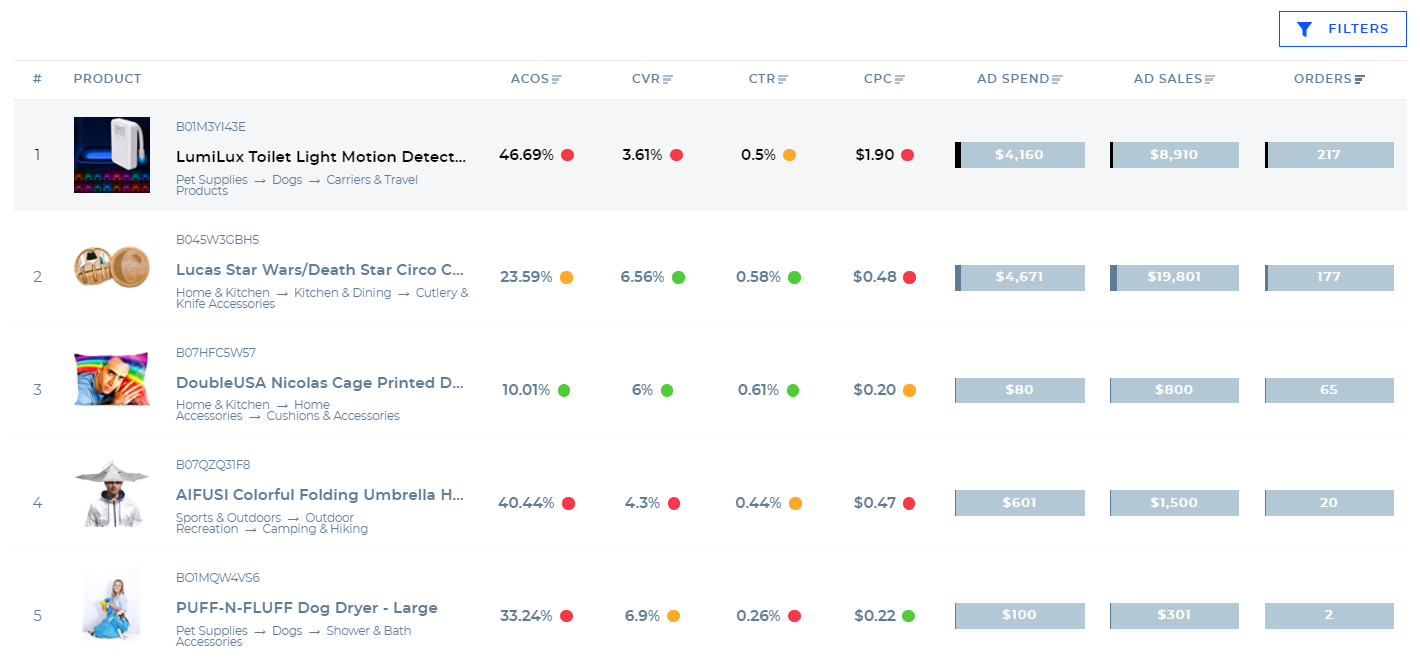
How to calculate target and break-even ACoS for your Amazon ads
Benchmarking the ACoS for your Amazon ads against your peer group allows you to see if there is potential to increase the efficiency of your campaigns by optimizing your bids or by adding more negative keywords. (Of course, the same goes for RoAS benchmarks.)
However, determining which ACoS values are realistic and what a good ACoS also depends on individual factors for each advertiser. Similar to CPCs, to define a realistic or good ACoS you have to ask yourself what you can afford to pay (depending on your profit margin) and what you are willing to pay (depending on your advertising goals).
To determine what ACoS is best for your business, take the following steps.
Step 3: Find your target ACoS
Step 1: How to calculate your profit margin
The diagram below shows how the cost structure for a typical product might look.
⬛︎⬛︎⬛︎ IMG filename:
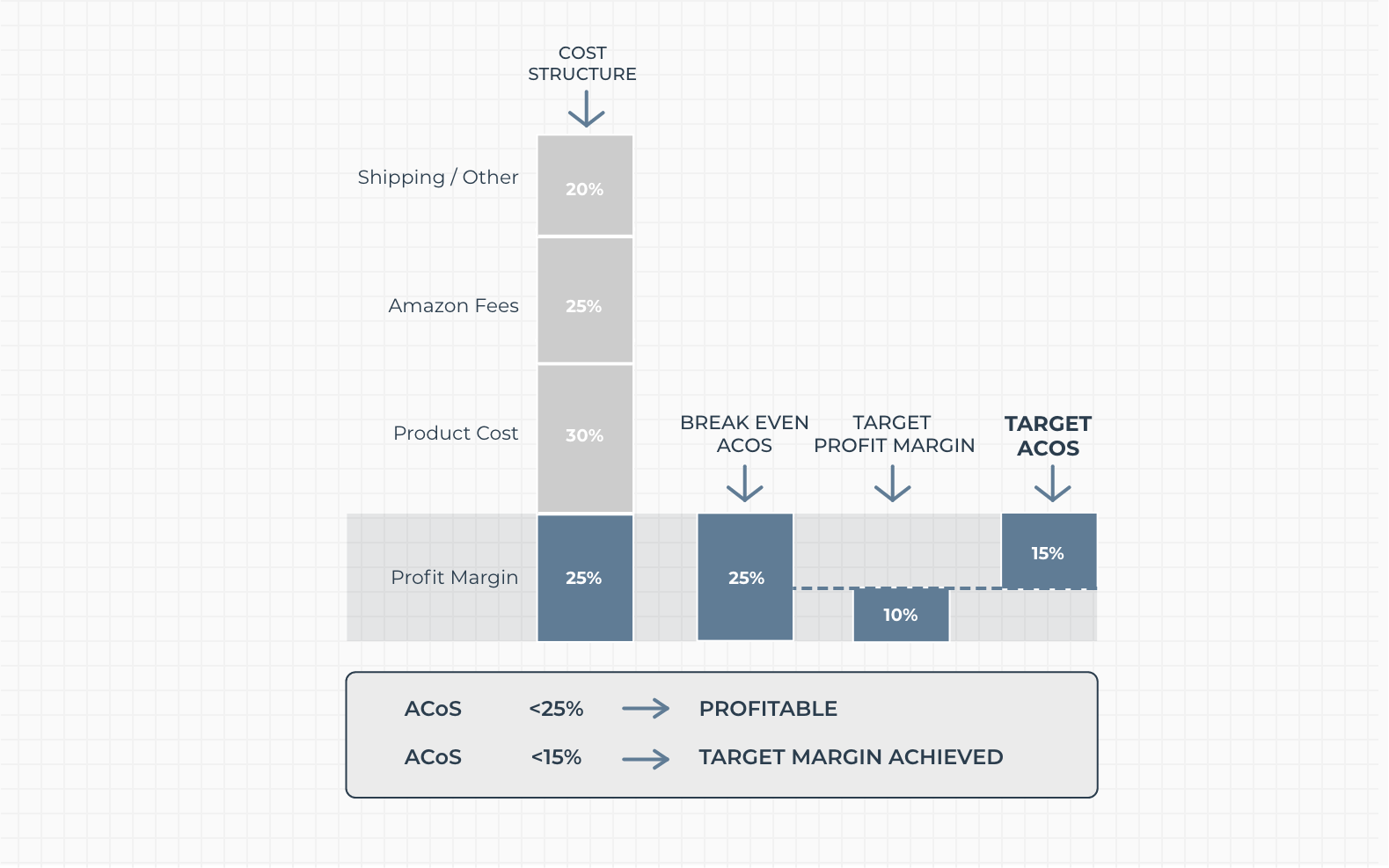
Typical cost blocks are:
the cost of goods (manufacturing costs)
costs for shipping the product from a manufacturer or to the customer
Amazon fees (referral fees, Amazon FBA fees, etc.).
To determine your profit margin, you need to subtract all these costs (per unit) from your product price.
Top sellers use cutting-edge advertising tools
Perpetua offers the most advanced Amazon PPC solution on the market, with all the tools, resources, and expert support you need to build successful campaigns for your products. And what’s more, it couldn’t be easier to get started. Request a free demo today to discover the industry’s premier optimization and intelligence software for Amazon Ads.
For example, say you sell your product for $200. All your costs amount to $150 per unit, so in the end you make $200 – $150 = $50 profit per unit. That means you have a $50 / $200 * 100 = 25% profit margin.

Step 2: What is the break-even ACoS on Amazon? (Do I make a profit?)
Break-even ACoS on Amazon is equal to your profit margin. This is because ACoS is the proportion of revenue you're spending on ads, and profit margin is the proportion of revenue that you’re earning as a profit (before ad spend).
When ACoS is equal to profit margin, you’re spending all of your profit on ads—you’re breaking even. That’s why your profit margin represents the tipping point at which a campaign either makes or loses money.
If your ACoS is higher than your profit margin, you're spending more than you're making and your campaign is losing money. If your ACoS is lower than your profit margin, you're bringing in more than you're spending and that means you're turning a profit.

Therefore, as your break-even Amazon ACoS corresponds to your profit margin, this—simply put—means that you will continue to make money as long as you don’t spend more than your profit margin on advertising.
Break-Even ACoS = Profit MarginThe break-even ACoS is a benchmark that allows you to see immediately if your campaigns are making a profit or a loss.
In our example from Step 1, the profit margin—and the break-even ACoS—is 25%. As long as you don’t spend more than 25% on Amazon ads, you won’t lose money. Or, in other words, you shouldn’t exceed an ACoS of 25% to remain profitable with your Amazon ad campaigns.
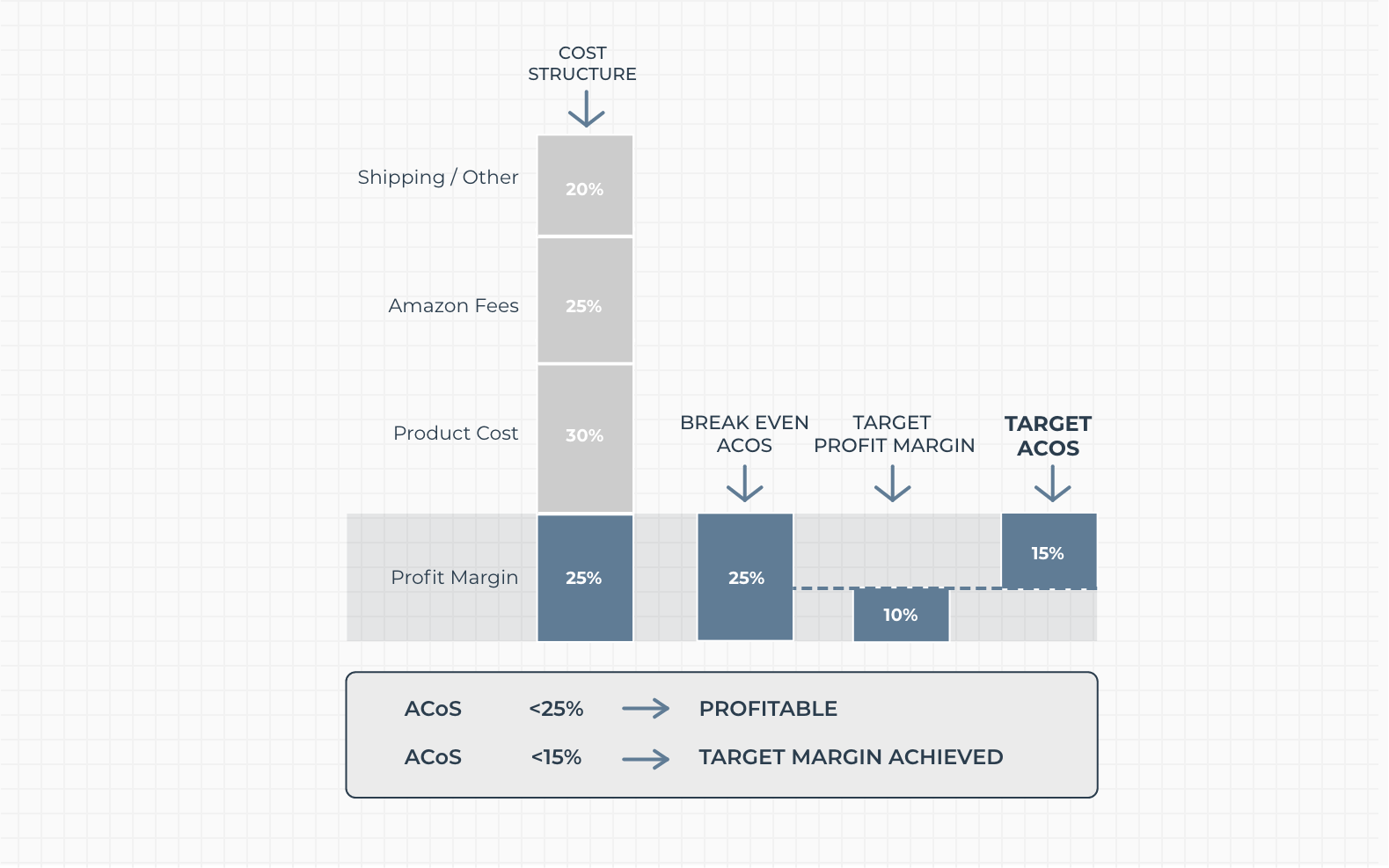
Important: The break-even ACoS is based on a product-specific profit margin. If you gather products with very different profit margins—and break-even Amazon ACoS numbers—in an ad group, it can be difficult to see whether your campaign is actually profitable or not. That’s why we recommend using only one product per ad group or to only group products with similar margins.
Top sellers use cutting-edge advertising tools
Perpetua offers the most advanced Amazon PPC solution on the market, with all the tools, resources, and expert support you need to build successful campaigns for your products. And what’s more, it couldn’t be easier to get started. Request a free demo today to discover the industry’s premier optimization and intelligence software for Amazon Ads.
Still using marketplace-level benchmarks?
Then you're not making meaningful comparisons. To understand your performance in context, you need to compare your ads to other sellers in the same country, subcategory, and ad format.
And there's only one place where you can get data of this caliber: the free Benchmarker. Try it and unlock your advertising potential today!
Step 3: What is my target Amazon ACoS? (Do I make enough profit?)
In many cases, you not only want to break even with your campaign, but actually keep a certain profit margin. Making money is ultimately the reason you're probably selling on Amazon to begin with. Your target ACoS is the ACoS at which you achieve this target profit margin. Here’s how to calculate your target ACoS on Amazon:
Target ACoS = Profit Margin (Before Advertising) – Target Profit Margin (After Advertising)The target ACoS is a benchmark that allows you to see immediately if your campaigns are achieving your target profit margin.
Here's our example from above:
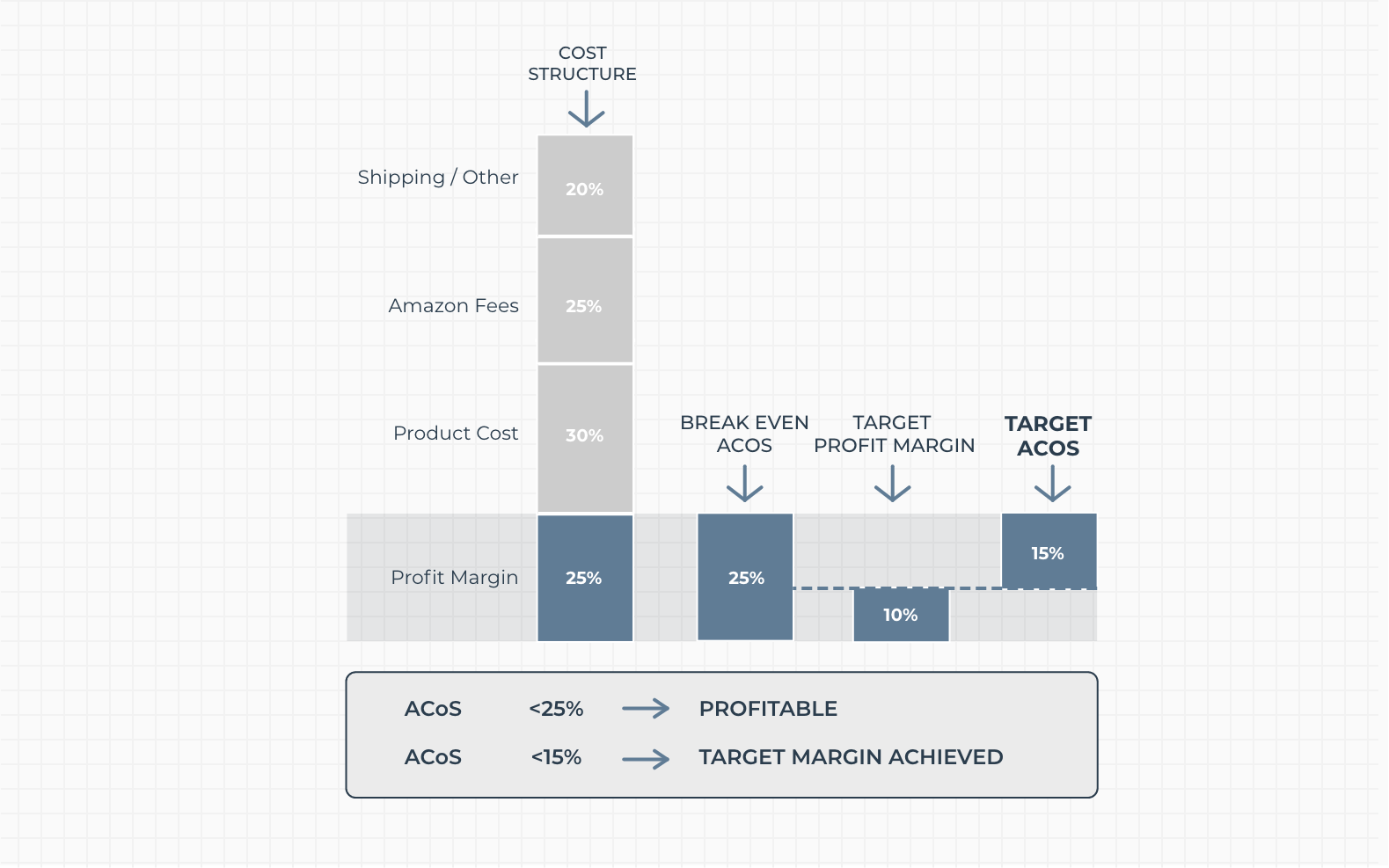
In this example, your break-even ACoS (profit margin) is 25%. If you want to keep a profit margin of 10% after advertising, you can only spend 15% of your revenue on advertising.
Target ACoS (15%) = profit margin before advertising (25%) – target profit margin after advertising (10%)In this example, your target ACoS is 15%. If your Amazon ACoS is higher than 15%, you will miss your target profit margin.
Choosing the Right Amazon ACoS Based on Your Goals
There are different goals you can pursue with your PPC campaigns. Depending on your goals, you can either focus on break-even ACoS or a lower target ACoS:
Goal 1 – maximizing sales: this goal makes sense if you’re launching a new product to get reviews and sales as quickly as possible to push your organic ranking. In this case, you might focus on getting as many sales as possible while breaking even, meaning you would aim for your break-even Amazon ACoS (or even higher for a certain time).
Goal 2 – maximizing impressions: maximizing impressions makes sense if you want to increase your brand awareness. In this case you might focus on getting as many impressions as possible while breaking even, meaning again that you would aim for your break-even Amazon ACoS.
Goal 3 – making a profit: this should be the long-term goal for established products. To achieve a certain profit margin you should focus on reaching your target Amazon ACoS.
Top sellers use cutting-edge advertising tools
Perpetua offers the most advanced Amazon PPC solution on the market, with all the tools, resources, and expert support you need to build successful campaigns for your products. And what’s more, it couldn’t be easier to get started. Request a free demo today to discover the industry’s premier optimization and intelligence software for Amazon Ads.
Worried about your ACoS?
You can easily reach your desired ACoS with Perpetua's Ad Engine. Simply set your target ACoS, and our software will automatically adjust your bids, saving time and effort. If you'd like to maintain more control, you can use our advanced levers to create a setup customized to your specific needs.
Total ACoS (TACoS) as an additional advertising metric
Your ACoS for Amazon PPC only takes into consideration the sales that you make through ads. For this reason, ACoS may not be the most important metric to use if you are:
trying to scale your business
launching a new product
trying to achieve better keyword rankings.
If you are trying to achieve any of the goals listed above, it’s worthwhile to look at your total advertising cost of sale (TACoS). TACoS takes into account both your ad sales and your organic sales (sales not made through ads) to show how your ad spend fits into your overall business.
Some of the most common TACoS use cases are:
understanding your overall profitability
monitoring reliance on advertising for your account or specific products
analyzing the effect of ad sales on organic sales.
For more information on this essential metric, check out our guide to TACoS.
My Amazon ACoS Is Too High—How Do I Lower My ACoS on Amazon?
So far, we’ve talked about the meaning of Amazon ACoS and how to get ACoS and RoAS benchmarks, and your break-even and target ACoS. Now you’re probably wondering, “Is my Amazon ACoS too high?” And, “How can I improve my ACoS?”
We will answer this question in 2 steps:
Step 1: Which metrics drive ACoS on Amazon?
Step 2: How to optimize your ACoS using these metrics?
Before we start with these questions, however, let’s quickly take a look at this important question:
Does a low Amazon ACoS always mean a good Amazon ACoS?
Many advertisers fear that their ACoS on Amazon is too high. But depending on your category, the time of year, and your product portfolio, a high ACoS strategy on Amazon ads is not necessarily a bad thing.
For example, if your advertising goal is to maximize your reach by getting as many impressions as possible or maximizing sales for a product launch, efficiency or profitability may not be the priority.
Important: There is a general trade-off between ACoS and sales or impressions.
In many cases, with a lower bid and cost per click (CPC) your Amazon ACoS tends to be lower, and profit per unit tends to be higher because your cost per unit is lower. However, a low bid also leads to fewer impressions and therefore fewer clicks and sales.
Overall, when optimizing ACoS for Amazon ads, you should think about efficiency, profitability and sales, and the number of impressions you are getting.

Step 1: Which Metrics Drive ACoS on Amazon?
Let’s start by taking a look at the most important Amazon PPC metrics:
Bid: if your bid wins the advertising auction, your product appears in position #1. If your bid is lower, your ad can still receive one of many other ad placements throughout Amazon.
Impressions: the more people see your ad, the higher the chances that someone buys your product.
Click: Amazon shoppers will click your ad if they deem it relevant to their search.
Click-through rate: calculation of (clicks ÷ impressions), measures how interesting and relevant your ad is.
Cost per click (CPC): What you pay per click—the true price of the ad auction. Your CPC depends on your bid, the competition, and your quality score. Because the bid auctions are second-price auctions, where you pay $0.01 above what would be required to beat the bidder behind you, your CPC will always be lower than the actual bid.
Orders: the number of times a shopper has purchased your product after clicking your ad.
Conversion rate: calculation of (orders ÷ clicks), measures the persuasion power of your offer and product detail page.
Ad spend: calculation of (clicks x cost per click) to understand total ad investment.
Ad revenue: calculation of (orders x average selling price) to understand sales driven by ads.
Amazon RoAS (return on ad spend): calculation of (ad revenue ÷ ad spend), expressed as a ratio to understand how much revenue is earned for every dollar spent on advertising.
Amazon ACoS (advertising cost of sales): calculation of (ad spend ÷ ad revenue), expressed as a percentage to understand how much of every dollar of revenue is spent on advertising.
Top sellers use cutting-edge advertising tools
Perpetua offers the most advanced Amazon PPC solution on the market, with all the tools, resources, and expert support you need to build successful campaigns for your products. And what’s more, it couldn’t be easier to get started. Request a free demo today to discover the industry’s premier optimization and intelligence software for Amazon Ads.
Understanding what drives your ACoS for Amazon ads
To see which metrics drive ACoS for Amazon ads, let’s take a look at the Amazon ACoS formula again and how it can be broken down into the different factors. In its simplest form, Amazon ACoS goes up when ad spend grows faster than ad revenue or down when ad revenue grows faster than ad spend.

Ad spend is determined by the number of clicks and cost per click (CPC). Ad revenue is determined by the number of orders and the average selling price.

You can extend the ACoS formula even further to reveal two more key PPC metrics that govern your Amazon ACoS: click-through rate and conversion rate.
Clicks are the result of how often shoppers see an ad (impressions) and how often they click on it when they do (click-through rate). Orders are the result of the number of clicks and how often one of these clicks leads to a sale (conversion rate):

Tip: you can see all of these metrics for your account in one place with the free Benchmarker tool.
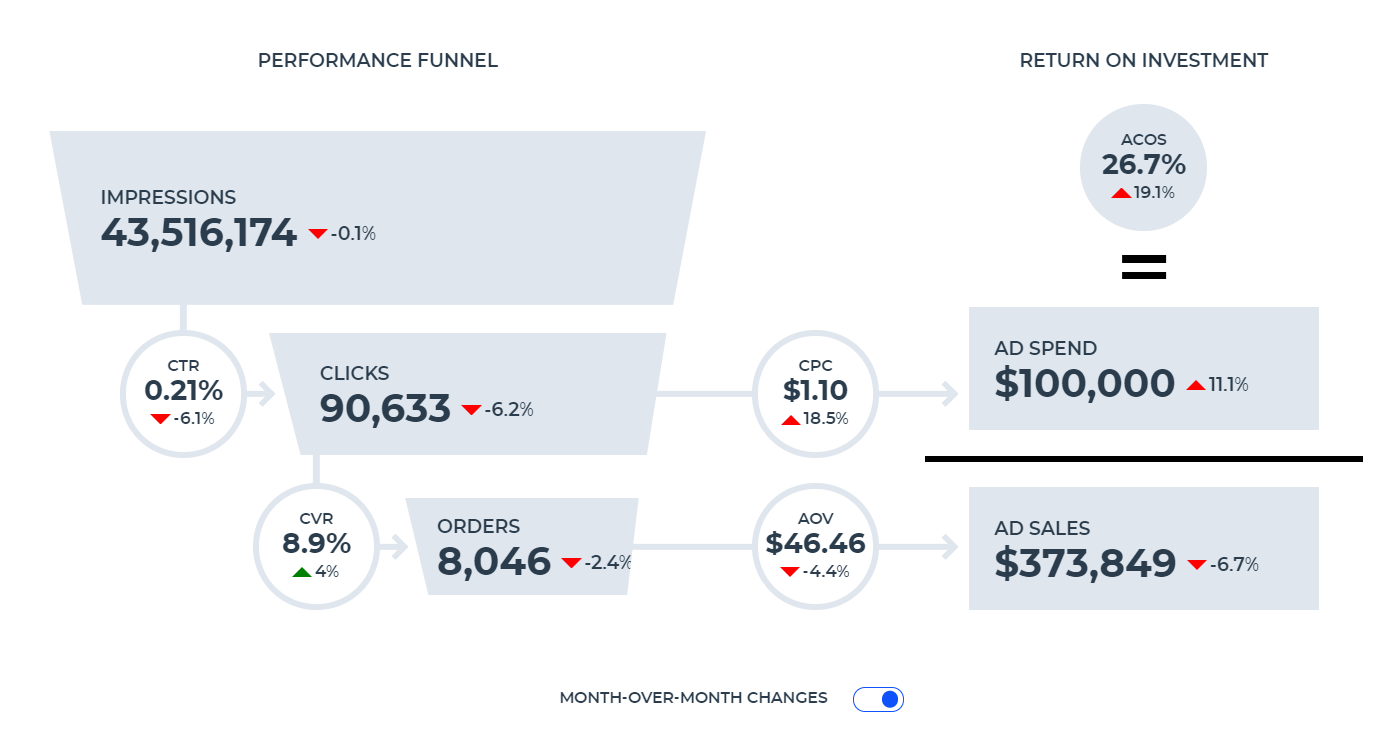
Step 2: Amazon ACoS Strategy—How to Optimize ACoS on Amazon
We have seen that Amazon ACoS (advertising cost of sale) depends on a few different metrics that are also dependent on each other. The most effective approach for ACoS optimization is to focus on the following metrics:
Let's take a closer look.
Amazon ACoS driver #1: click-through rate
Before optimizing, you need to understand how good your click-through rate is compared to your competitors.
You can do this for free using the Benchmarker tool, which will compare your click-through rate to other sellers in your marketplace and subcategory.
By looking at your click-through rate in comparison with your peer group, you can see:
if there is potential to make your product ads (images, copy, reviews, etc.) more appealing to your customers;
if your ads are able to stand out from the crowd to convince customers to learn more about your product;
if you are targeting too narrow or too broad an audience in terms of keywords and ASINs/categories.
What determines my click-through rate?
These factors influence click-through rate:
Internal (easy to influence) | External (not so easy to influence) |
|---|---|
Targeting | Price |
Star rating | New competitors |
Main image | |
Product title | |
Prime eligibility | |
Number of reviews |
How can I optimize my click-through rate?
Refine the targeting of your campaigns. Conduct Amazon keyword research (e.g. with Sonar) to identify the most relevant keywords. Use negative keywords to prevent your ads from being shown for irrelevant searches.
Optimize your product images, making sure they stand out from the crowd and match Amazon’s quality, background, angle and perspective requirements.
Increase your star rating by closely monitoring reviews and making improvements to your product and product detail page based on negative customer reviews.
With Perpetua, you can automate keyword harvesting to save time and effort. Or if you prefer to have more control, you can set a conversion threshold so that the Ad Engine only harvests a keyword after a set number of sales.
Top sellers use cutting-edge advertising tools
Perpetua offers the most advanced Amazon PPC solution on the market, with all the tools, resources, and expert support you need to build successful campaigns for your products. And what’s more, it couldn’t be easier to get started. Request a free demo today to discover the industry’s premier optimization and intelligence software for Amazon Ads.
Perpetua's Ad Engine will also automatically reduce bids for keyword and ASIN targets that get clicks but not conversions. This way, you can be sure you aren’t wasting ad spend on under-performing keywords.
Click-through rate or conversion rate problem?
With the free Benchmarker, you can see exactly which products are getting clicks, but not converting. Additionally, you can also see how each product’s KPIs compare with other sellers in your category and marketplace. Get the insights you need to take your Amazon PPC performance to the next level. Try the free Benchmarker today!
Amazon ACoS driver #2: cost per click (CPC)
Cost per click varies widely across marketplaces and product categories.
The Benchmarker will provide you with the median CPC not only for your marketplace, but also for your subcategory, allowing you to know that you are working towards the right goal.
If your CPC is above the benchmark—in this example, $0.28—you might be overpaying for your ads and wasting ad spend. On the other hand, if your CPC is below the benchmark, your bids are probably not as competitive as they could be and you are likely missing out on valuable impressions and sales.
An exception is if you are investing in advertising for a product launch or if you are simply trying to maximize impressions or sales. In these cases, it can make sense to have a CPC that is above the benchmark.
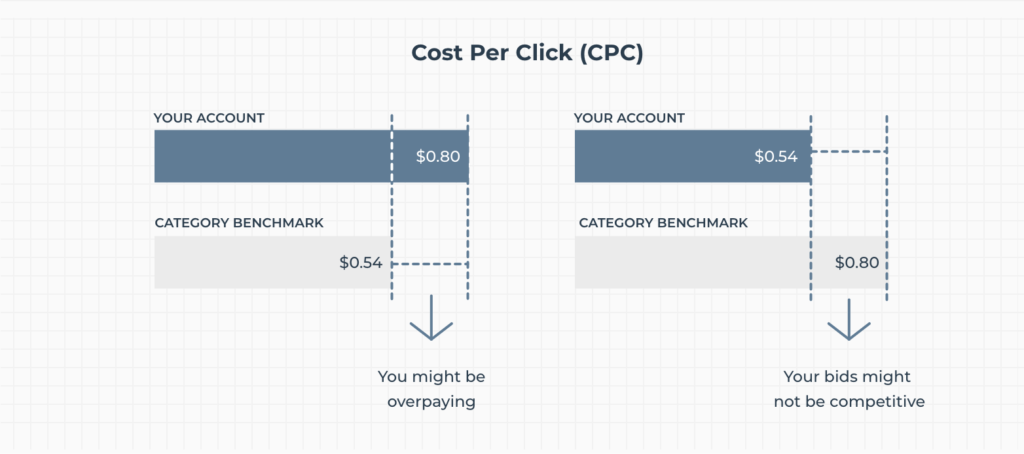
Your CPC depends on your bid, the competition, and your quality-score.
Amazon’s bid auctions are second-price auctions, where you pay $0.01 above what would be required to beat the bidder behind you. Because of this, your CPC will always be lower than the actual bid.
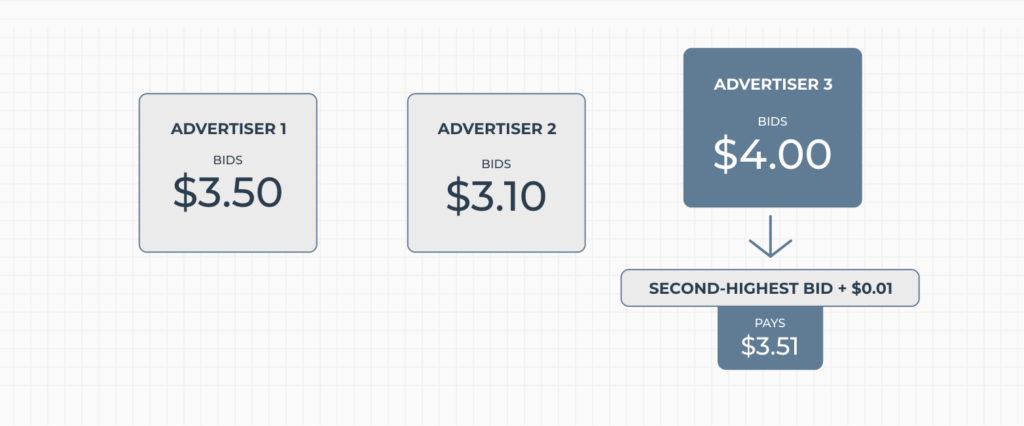
Remember that the greater the competition, the more you will have to pay for your bid to be competitive. Seasonal trends can also influence the number of advertisers bidding for keywords and therefore the average CPC.
For example, think of the weeks preceding Christmas, when people do a lot of shopping. This is a time period when more advertisers are bidding for keywords, resulting in higher CPCs.
The type of bidding strategy you choose can also have a significant impact on your overall CPC. For more on that topic, check out this article.
How can I optimize my CPC?
1. Determine your advertising goal and target ACoS. Is your goal to maximize sales or impressions (higher target ACoS or break-even ACoS), or is it to run a profitable campaign (lower target ACoS)? Define a target ACoS for each campaign/ad group to guide your CPC optimization.
2. Optimize bids on a regular basis. Depending on the target ACoS, competition, and conversion rates, the optimal CPC will differ for each keyword in your campaigns. And these conditions change over time. That’s why it’s important to adjust your bids regularly to achieve and maintain an optimal CPC for each keyword.
Amazon ACoS strategy: as a general rule increase your CPC if your ACoS < target ACoS and decrease CPC if your ACoS > target ACoS.
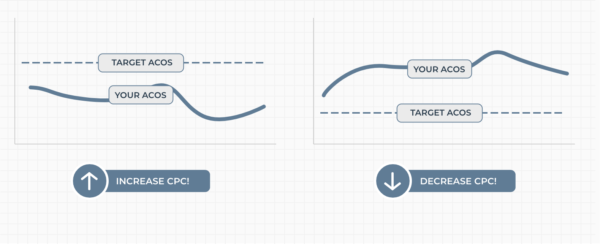
Avoid manual effort
As the best practice strategies described here follow logical rule sets, they can be automated. Save time and effort without compromising on results by using Perpetua. Let our Ad Engine manage your bidding optimization for you.
Amazon ACoS driver #3: conversion rate (CVR)
What is a good conversion rate in your category and marketplace? Find out with the Benchmarker.
To put it simply: if CVR goes up, Amazon ACoS goes down (and vice versa).

Conversion rate is calculated by dividing the number of orders by the number of clicks (orders ÷ clicks) and is more dependent on your product detail page than any other PPC metric.
When shoppers click your ad, they confirm that it is relevant to their search query. After that, your product detail page needs to convince the shopper to buy your product. Your goal should always be to increase your conversion rate.
Let’s look at the primary internal and external factors that influence conversion rate.
Top sellers use cutting-edge advertising tools
Perpetua offers the most advanced Amazon PPC solution on the market, with all the tools, resources, and expert support you need to build successful campaigns for your products. And what’s more, it couldn’t be easier to get started. Request a free demo today to discover the industry’s premier optimization and intelligence software for Amazon Ads.
How can I optimize my conversion rate?
Optimize your product content: images, titles, bullet points, description, A+ Content, videos
Manage your product reviews and questions
A/B test prices
Amazon ACoS driver #4: average sales price
Average sales price is calculated as the total revenue divided by the number of products units sold.

Average sales price is an often-overlooked factor that has a large impact on ACoS. In a nutshell: the higher your average sales price, the better your ACoS will be, assuming all other metrics stay the same.
When setting prices for your products, it can be difficult to strike a balance between profitability and competitiveness, especially in large marketplaces like Amazon. For more information about pricing strategies, check out our blog article.
What influences my average sales price?
The three most important factors that will influence your average sales price are:
the price a buyer is willing to pay
the price a seller (you) is willing to accept
the price that’s competitive in the market.
If your average sales price increases and all of your other metrics stay the same, your Amazon ACoS will decrease and your ads will be more profitable (per unit sold).

Other factors that can influence Amazon ACoS
Click-through rate, cost per click, conversion rate, and average sales price aren’t the only factors that can influence your ACoS. Here's a quick look at a few more.
Attribution window
The attribution window is the time period after an ad click that a sale can occur and be attributed to your advertising campaign.
For example, if the attribution window is 7 days, and a shopper clicks on an ad today and then purchases that product 7 days from now, the sale will be attributed to your ad campaign.
Remember that the sum of all of the sales attributed to your ad campaign is equal to your total ad revenue. Because ad revenue has one of the biggest influences on ACoS, it’s important to understand how Amazon’s attribution window can influence your ad revenue numbers.

Attribution windows vary depending on the ad type and the type of seller you are on Amazon. Below is a summary of all of the most important information about Amazon attribution that you need to know.
Sponsored Products attribution window
Seller Type | Attribution Window | Products Included | Reporting Date |
|---|---|---|---|
Sellers | 7 days | All sold products in inventory of the seller, whether advertised or not. | Date of the ad click |
Vendors | 14 days | All sold products, whether advertised or not, but only those products sold by Amazon, not by other sellers. | Date of the ad click |
Let’s look at a quick example to see how the attribution window could impact your overall ad revenue.
If you’re a seller and someone clicks on one of your Sponsored Products ads on Black Friday (November 26) and then makes a purchase on December 1, the sale would be attributed to your November sales, not your December sales.
Top sellers use cutting-edge advertising tools
Perpetua offers the most advanced Amazon PPC solution on the market, with all the tools, resources, and expert support you need to build successful campaigns for your products. And what’s more, it couldn’t be easier to get started. Request a free demo today to discover the industry’s premier optimization and intelligence software for Amazon Ads.
So if you are analyzing your holiday sales and only looking at your December sales numbers, you would be missing sales that actually occurred in December (and are holiday-related) but were attributed to your November ads because of Amazon’s attribution window. (Remember: Sponsored Products sales are reported on the date of the ad click.)
Now let’s take a look at how the attribution window works for other ad types.
Sponsored Brands attribution window
Seller Type | Attribution Window | Products Included | Reporting Date |
|---|---|---|---|
Sellers & Vendors | 14 days | All products within the brand, whether advertised or not, sold by you, by Amazon, or by other sellers | Sales reported on day of sale |
Sponsored Display attribution window
Targeting | Seller Type | Attribution Window | Products Included | Reporting Date |
|---|---|---|---|---|
Audience: Interest | Sellers and Vendors | 14 days | All products within the brand, whether advertised or not, sold by you, by Amazon, or by other sellers | Date of sale |
Audience: Views Remarketing | Sellers | 14 days | All products within the brand, whether advertised or not, sold by you, by Amazon, or by other sellers | Date of ad click |
Audience: Views Remarketing | Vendors | 14 days | All products in inventory, whether advertised or not, but only those products sold by Amazon, not by other sellers. | Date of ad click |
Product Targeting | Sellers and Vendors | 14 days | All products within the brand, whether advertised or not, sold by you, by Amazon, or by other sellers | Date of ad click |
Please note: product targeting sales of sellers’ campaigns created before March 17, 2021 included all products in your seller inventory, whether advertised or not, as opposed to products within your brand.
Tip: You can view sales attributed to a campaign for a given time frame by downloading a Campaign Performance report.
For more details about Amazon attribution windows, check out this article.
Seasonality
Seasonal changes in advertising costs and advertising revenue can also have a significant impact on your overall ACoS.
For example, businesses typically see significant revenue increases for big shopping holidays like Prime Day, Black Friday, and Cyber Monday. In 2019, the last year for which we have reliable data (2020 data is unrepresentative due to the Coronavirus pandemic), ad revenue increased by 156% on Prime Day, 104% on Black Friday, and 159% on Cyber Monday.

While these big deal days are also often accompanied by higher CPCs, and thus higher advertising costs, revenue increases normally outweigh the increase in costs, leading to a better ACoS.
So when analyzing your ACoS over the course of the year, many brands see improvements in ACoS associated with deal days. And, of course, a deterioration in ACoS after the deal days have passed.
For this reason, it’s important to understand and consider seasonal factors that could be influencing your ACoS.
Top sellers use cutting-edge advertising tools
Perpetua offers the most advanced Amazon PPC solution on the market, with all the tools, resources, and expert support you need to build successful campaigns for your products. And what’s more, it couldn’t be easier to get started. Request a free demo today to discover the industry’s premier optimization and intelligence software for Amazon Ads.
Optimizing Amazon ACoS: Key Takeaways
At the end of the day, you can understand your ACoS on Amazon with a series of simple math equations. As you investigate what’s causing changes in your Amazon ACoS, approach each metric one by one, and look for disproportionate changes.
One of the best places to see all of your metrics in one place for free is the Benchmarker. The Performance Funnel section displays all of your performance metrics, allowing you to easily identify what is causing changes in your ACoS.
Tip: click the month-over-month button to track your performance over time.

By identifying the metrics that are having an undesirable impact on your ACoS, you can make the changes we’ve described in this article to achieve your ACoS goals.
See the product analysis section in the Benchmarker to identify strengths and weaknesses in the metrics of each of your products.
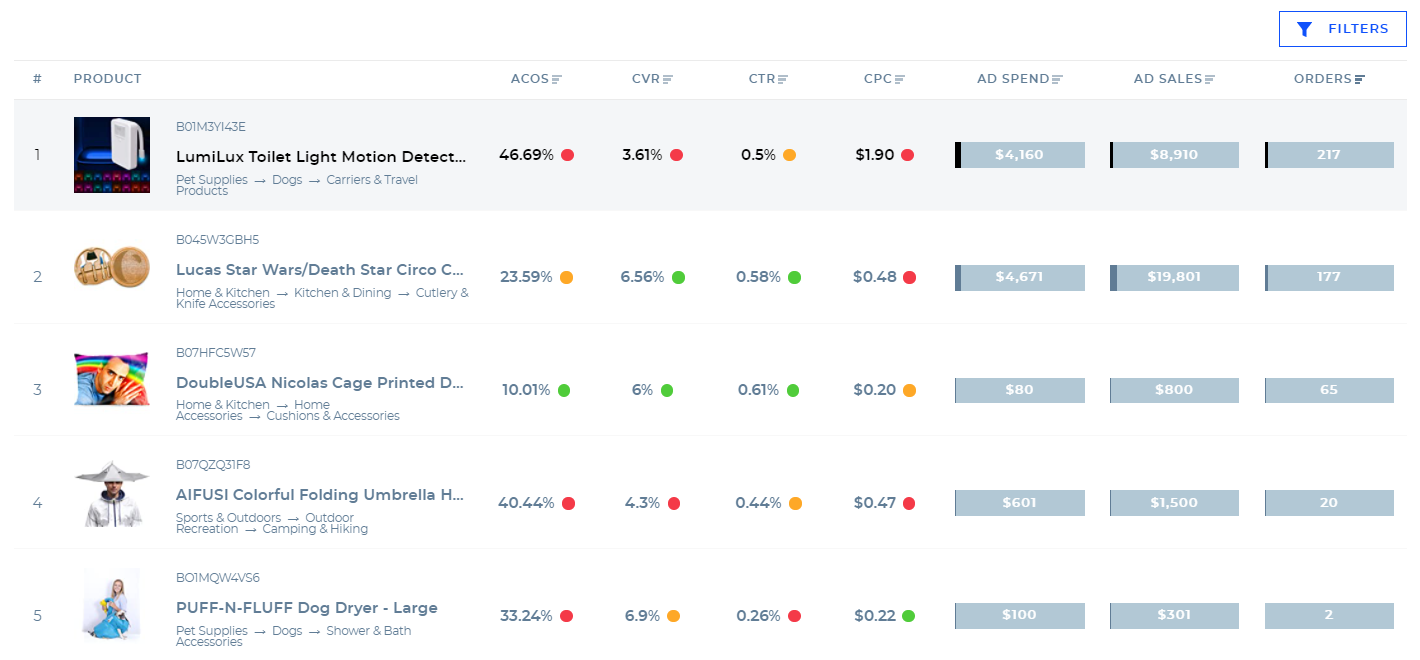
Still using marketplace-level benchmarks?
When you're not making meaningful comparisons. To understand your performance in context, you need to compare your ads to other sellers in the same country, subcategory, and ad format.
And there's only one place where you can get data of this caliber: the free Benchmarker. Try it and unlock your advertising potential today!
Amazon ACoS FAQ
What is ACoS?
What is Amazon ACoS?
What is a good ACoS for Amazon?
How do I find my ACoS on Amazon?
To get started or learn more about how Perpetua can help you scale your Amazon Advertising business, contact us at hello@perpetua.io